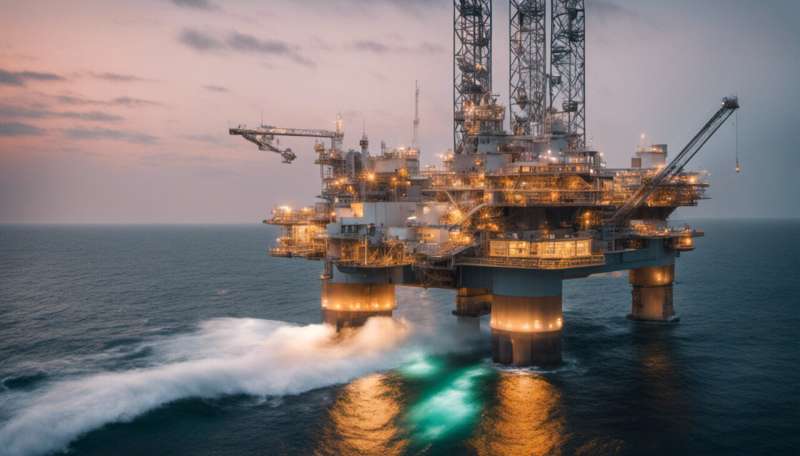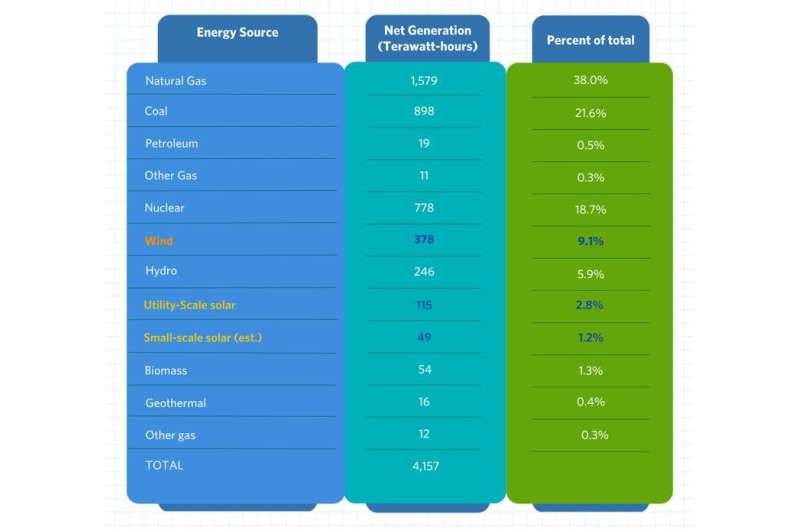This article has been reviewed according to Science X's editorial process and policies. Editors have highlighted the following attributes while ensuring the content's credibility:
fact-checked
trusted source
proofread
Q&A: Offshore wind power's last mile

Offshore wind power has the potential to provide all the electrical power needed by the Northeast with thousands of extremely large wind turbines located offshore. But one of the biggest hurdles to creating that reality is getting the wind power from offshore generation points to the power grid on land.
Overcoming those hurdles is both an engineering and a political challenge. And Tufts students and faculty are in the midst of efforts to solve both. Their work has the potential to generate thousands of new jobs and fuel a massive infrastructure effort not seen since the New Deal in the 1930s.
Tufts Now recently spoke with Eric Hines to get a better understanding of those "last mile" engineering and political challenges. Hines is Professor of the Practice and Tsutsumi Faculty Fellow in the Department of Civil and Environmental Engineering at Tufts School of Engineering.
How important is wind power overall in the US right now?
In 2021, utility scale wind and solar power from large-scale farms provided approximately 12% of the electricity generated in the U.S. That's an amount dwarfed by fossil fuels, which account for approximately 60% of total U.S. electricity production—with nuclear, hydroelectric power, and other renewables being the other major sources.
We have heard a lot about offshore wind farms in New England. Why build them there? And what companies are involved?
Consistent winds and shallow federal waters on the Outer Continental Shelf make New England and the Mid-Atlantic among the best places to build offshore wind farms in the U.S. While Iowa, Texas, and Oklahoma also offer ideal locations for generating land-based wind energy, state decision-makers on the East Coast have been attracted to our offshore wind resource because it is so close to our major coastal cities.
Thus far, the Europeans have invested a lot more than the U.S. in developing offshore wind technology. Currently, it is predominantly companies from Denmark, Norway, the Netherlands, Germany, France, Spain, and Portugal that are obtaining leases from the U.S. federal government to create wind farms off the coast of New England and the Mid-Atlantic states.
Is wind power more costly?
While there is a lot of infrastructure involved, ultimately, the average price of offshore wind power contracted for purchase to date is comparable to average wholesale electricity prices from fossil fuels in New England in 2022.
Are wind farms more effective as an energy resource than solar panels?
From our perspective, solar energy and wind energy are complementary renewable energy sources. Neither solar nor wind energy alone can do the job. We need both.
In order to understand offshore wind, one has to consider scale. A single wind turbine is taller than Boston's Prudential Tower. Approximately 1,000 of these mammoth offshore wind turbines operating at 100% capacity could generate all the power New England needs. Renewables such as solar and wind operate, however, at approximately 25% to 50% capacity due to the natural variations in resource availability. Solar is on the lower end of this capacity spectrum and offshore wind is on the higher end.
Electricity demands fluctuate daily and seasonally, and a few times per year peak demands can reach more than twice the typical daily demand. Furthermore, to cut CO2 emissions, we must transition our energy sector to an electricity-based system where we generate our electricity with renewables. Assuming a 100% increase in electricity demand between now and 2050 and a 50% capacity factor, approximately 4,000 offshore wind turbines plus well-designed storage could meet New England's energy needs in 2050.
By comparison, to generate a similar amount of energy, you would need solar panels blanketing every home as well as miles and miles of open land. Large office buildings in downtown Boston or Manhattan couldn't build enough onsite solar panels to supply their energy needs.

Getting all the power generated by wind turbines into the on-land power grid is a huge challenge, isn't it?
Currently, each offshore wind project is seeking its own unique connection to our existing land-based grid via a point of interconnection. This is complicated by the fact that offshore wind lease areas are awarded by the federal government and power purchase agreements are awarded by individual states. This rapidly evolving and complicated regulatory system has led, for example, to more than one company developing plans to provide energy to New York from wind farms off the Massachusetts coast.
There is ongoing work in several states and at the federal level to develop long-range plans that can avoid 200 or 300 different cables landing on our sensitive coastlines from different points offshore—it's the equivalent of a hodgepodge of extension cords.
If you build an addition to a house, you could supply all the energy through a bunch of extension cords from your old house into the addition. But instead, you hire an electrician and build a system that will be durable, efficient, and safe. We need to have the same approach to building our renewable energy supply with offshore wind power.
If, as a society, we do this right, we have the potential to simultaneously save the planet, create healthier communities, and create tens or even hundreds of thousands of new, high-paying jobs.
What are the biggest challenges?
This is where both political will and engineering come into play. The best solution would be to construct hardened and resilient tunnels, with really high-quality cables, and limit the number of on-land locations. But to do that, we need to break a traditional New England engineering practice: Never plug more than 1.2 gigs from a single source into the power grid.
The engineering challenge—and it's a big one—is: Can we design a system where we can plug more into one location in such a way that we don't short-circuit the country.
This extraordinarily complex issue requires engineers to think differently and to change the design of electricity substations by up to a 10-fold magnitude. Fortunately for us, there is much we can learn from Europe. In the North Sea, this concept of concentrating large amounts of power, including storage production via green hydrogen, has become known as "energy islands."
And then there is the challenge of political will. It will be critical for federal, state, and regional public entities as well as the private sector to work directly with the coastal communities who host these connectors. These communities should see significant economic investment, lots of jobs, the removal and cleanup of dirty power plants, and the restoration of wetlands.
The cables will be underground when they come on shore. You won't see anything, and these massive cables can be designed to land in sensitive coastal areas in ways that are safe and environmentally responsible. Once we do this, the resulting energy will be far cleaner. It will improve air quality, making a major dent in health problems like asthma. Thousands of jobs will be created both to build the tunnels and the plants and then also to maintain and run them.
How is Tufts helping to solve these dual challenges?
At Tufts, we are collaborating with colleagues at Iowa State, Clemson, the National Renewable Energy Lab, the Pacific Northwest National Lab, and groups in the UK, Norway, the Netherlands, and Demark to reinvent power systems for the energy transition. We are developing next-generation power systems education to handle both the technological challenges as well as the environmental and political challenges. Much of our scholarship is geared to help states and municipalities think effectively about how to develop offshore wind power and what the pluses and minuses will be depending on how they do it.
We are giving our students a front-row seat to the development of this new field. Our engineering students are acquiring the skills to make a quantum leap in power plant and electric cable technology. Students and faculty are exploring ways to address the environmental questions posed by bringing all that power generated offshore to the power grid without damaging our valuable coastal waters. And of course, we are educating our students about the many ways communities needed to be involved in the planning process so they can participate in the planning of these landing points.
Infrastructure is one of those things that we tend to take for granted. Much of our infrastructure built in the early and mid-20th century has lasted for decades and now is in need of repair. Our energy infrastructure is similar. To stop global warming, it needs to be reimagined and replaced—not only in the U.S. but world-wide. If we can meet this moment and to do it right in our own backyard, we'll have an opportunity to use what we have learned to help save the world.


















